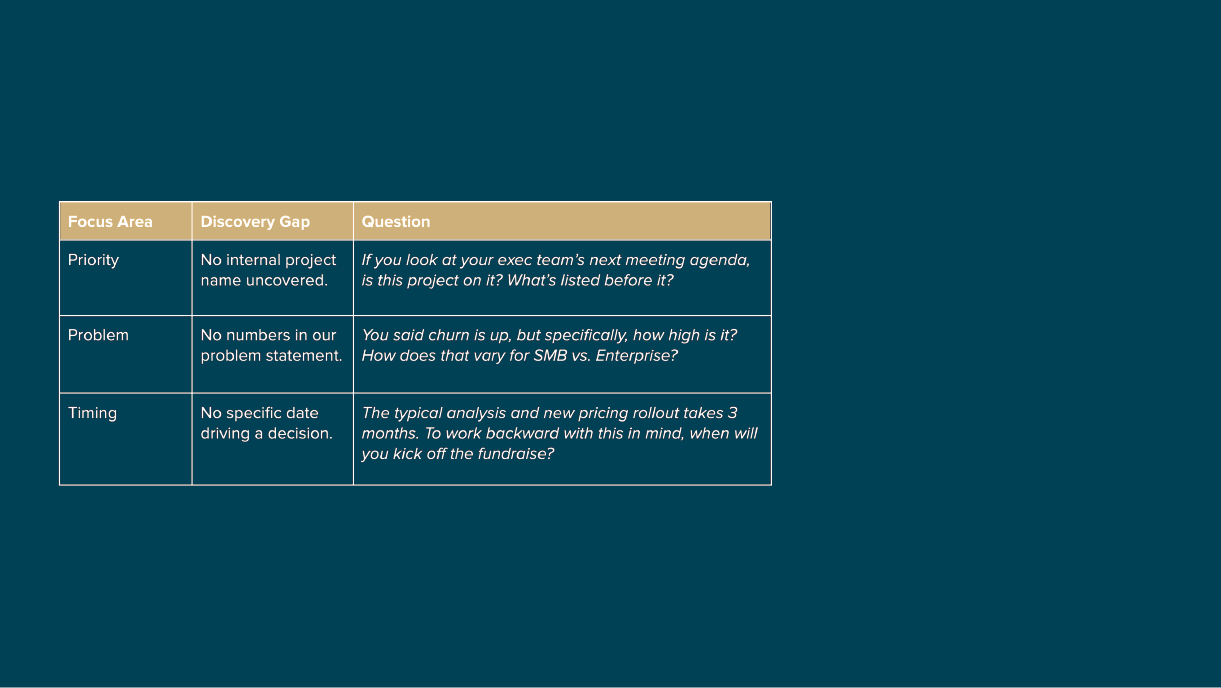13 Standout Mid-Funnel Email Frameworks You Should Steal. Right Now.
Emails make up the majority of your buyer’s experience in between sales meetings. What’s more, the bar for what a buyer considers a thoughtful email goes up as the cycle goes on.
Yet, the typical mid-funnel email is totally forgettable. It blends in, when it should stand out.
That’s because most reps build them with tired old templates, stale snippets, and stock phrases.
All of this means mediocre email content defines a large chunk of the buyer’s experience.
But you can change that. For your buyers — and your win rate. Reading this post will give you:
- A refreshed set of mid-funnel email frameworks to use right now.
- The principles behind them, so you know how to adapt them long-term.
Here we go. A mid-funnel email playbook you should steal.

1/ The Discovery Preview Email
Your prospecting email worked its magic. Now, you need your prospect to actually show up.
Their interest in giving you their time for a discovery call has likely decreased — not increased — since confirming your meeting time. This framework will build up their interest again by:
- Focusing on an outcome, not an agenda, a-la-Kyle Asay.
- Previewing a non-obvious insight to pique their curiosity.
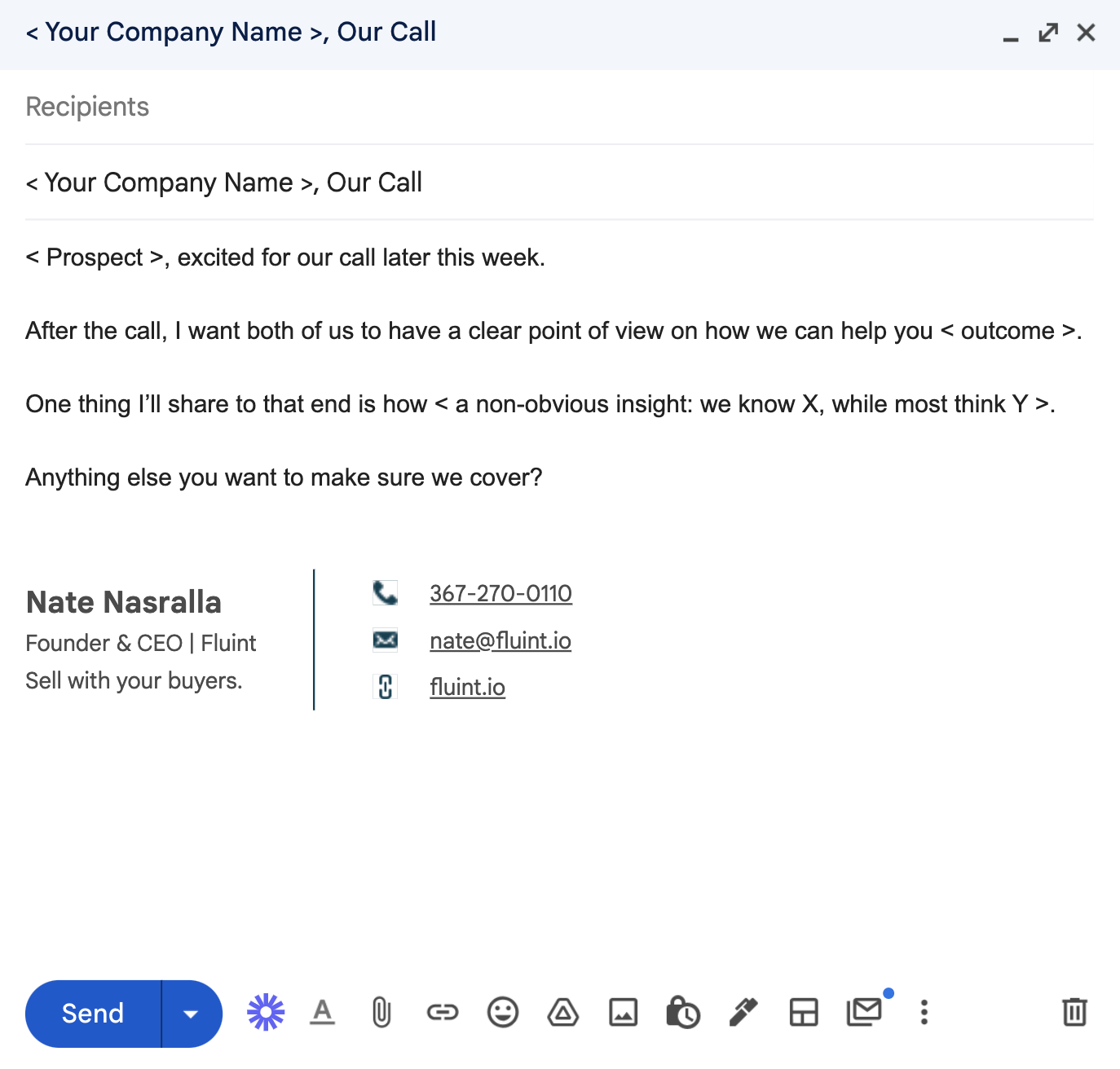
2/ The Problem & Approach Email
During your first discovery conversations, you should be asking questions to understand:
- Where your buyer is today: a problem.
- Where your buyer wants to be tomorrow: a payoff.
- The process to move them from problem, to payoff.
This email uses your buyer’s words to play back these points, ensure they feel heard, and showcase their logic for why they should move forward with another call.
The four steps in the framework are:
- A clear problem statement.
- How they want to approach the problem.
- What needs to be true of a solution for it to fit.
- Next steps, referencing a colleague who’s impacted.
Here's how it reads:
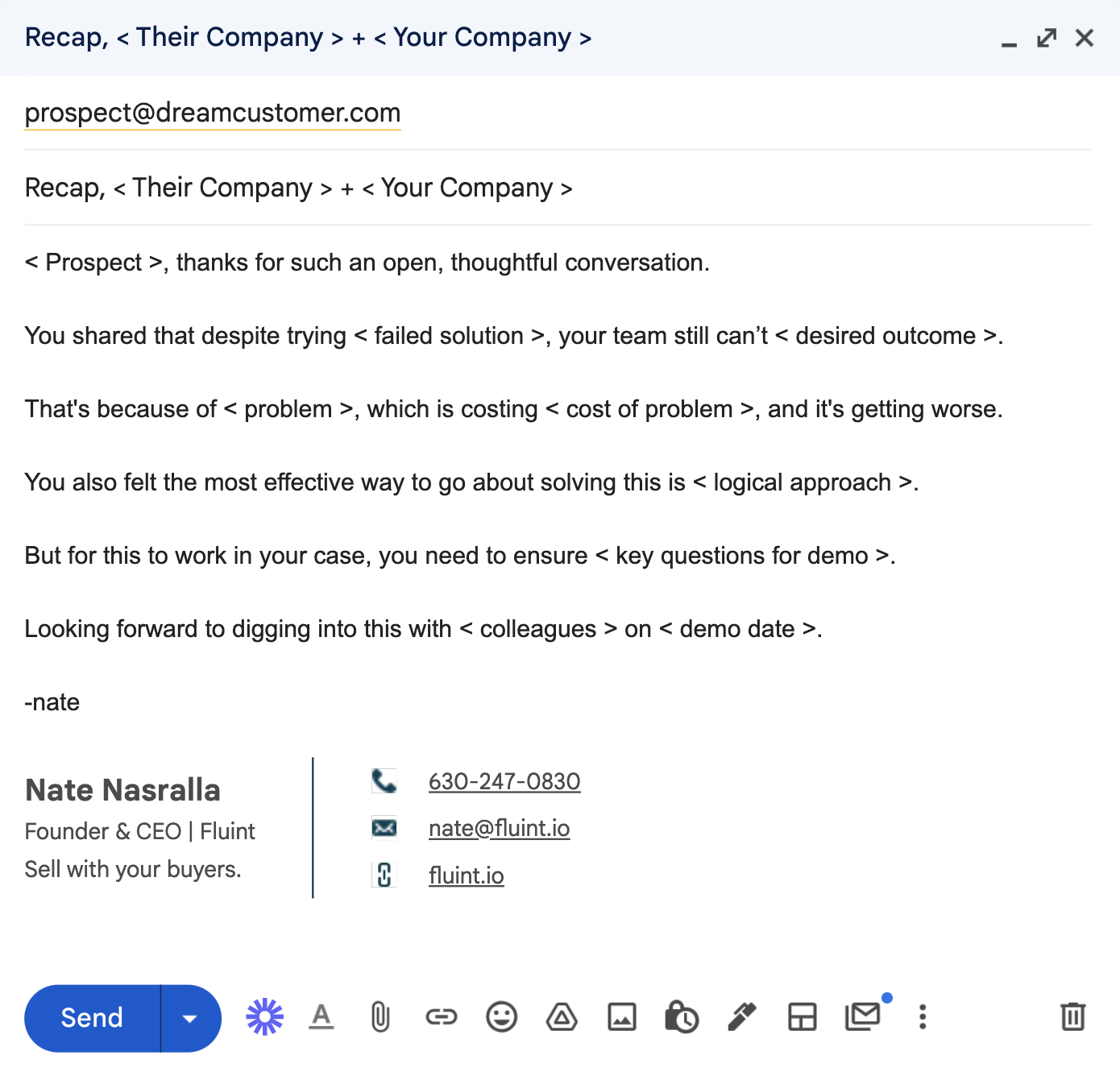
3/ The “Mad Libs” Post-Demo Email
If you joined Lavender Live with me and Will Allred, you saw us breakdown the typical post-demo email. A stack of links, padded with pleasant comments.
Here’s the “Before.”

The problem with this email is:
- It’s product-centric.
- The "link-stacking" puts the work back on the buyer.
- It doesn’t give champions material they'll use to guide internal conversations.
The way it reads to your buyer is:
Hi guys, this email took two minutes to generate because it’s a template.
But I’ll insert some nice language about how fun it was to talk.
Also, here’s a recap of my product:
- Product deck link
- Case study link
- Case study link
Thanks for digging through these links.
Hopefully you can hunt down some takeaways from them.
Also, please translate this into a new message your team will read.
Thanks, and hope to close you soon,
-Rep
If that sounds a bit harsh, that's the idea. You're capable of writing a far more effective email.
The way to do it? Pair your buyer’s words, captured in thoughtful notes, with this framework.
Think of it like that old game, Mad Libs. You’re filling in a storyline that builds up a greater level of emotional tension in your reader.
Here are the five parts to the Mad Libs framework, plus a good example of the “After” email.

4/ The Forwardable Email to Help You Multithread
Most reps send emails to their champions, when they should send them through their champions. Forwardable Emails are the way you'll do this.
This framework packages up your message so it's easy to forward along and:
- Loop in key contacts to expand your reach and multithread.
- Keep executives updated on the discovery they sponsored.
- Ensure your email is read by making the sender internal.
The 5 steps in this framework are:
- Open up with a company-wide initiative.
- Reference a trigger phrase that’s familiar.
- Stir up emotion using visual language.
- Create tension through a challenge.
- Match your ask to the decider’s job.
Here’s an example of how this might read for a rep selling an SEO content solution:

5/ The “Idea” Email That Stops Ghosting
This may surprise you, but buyers don't forget you sell a product. So they don't need the reminder in your follow-up emails. If your emails reference...
- Reviewing that proposal
- Scheduling with the SVP
- Booking another demo
...and you're not getting any response, then try this 'Idea Email'.
The difference is this email focuses on helping buyers get their job done today. Before they buy. You'll find that afterwards, they're more interested in hearing about the next steps in the deal.
The five elements in this framework are:
- Recall a past topic.
- Align it with a tool or idea.
- Confirm this is still a priority.
- Give proof your idea is helpful.
Here's how it reads:

6/ The “I Spent an Unreasonable Amount of Time on This” Email
If you never feel you’re spending an unreasonable amount of time writing follow-up emails to your pipeline, then head's up. You’re doing it wrong.
Here are three examples of what I mean. The first two are reasonable. The last one isn't.
🔴 The 50%-to-Quota Rep writes:
Hey, just wanted to follow up on meeting again.
You were thinking you’d have reviewed our deck by now?
🟡 The 75%-to-Quota Rep writes:
Hey, thought you’d like this whitepaper.
It has some pretty interesting findings in there.
By the way, when are you free to meet and review our deck?
🟢 The 150%-to-Quota Rep writes:
Hey, just read this 30-page whitepaper and had an idea.
Here's a copy, with the key takeaways highlighted for you.
I mapped the 3 main points, to 3 new slides in this deck we can build out together (and applied a media kit I found to brand it for you).
Think it's something we can get your team's feedback on it?
While writing up this last example, you’ll question yourself. You’ll think, "Does it really make sense to spend this much time, writing this one email?"
Optimizing your follow-up’s so they don’t cost you too much time is reasonable. But that gets you to the exact same place as your competitors.
On the flip-side, Costly Signaling Theory says the more it costs you to communicate something, the better your message will land.
7/ The No-Reply-Required Email
Ideally, an executive is sponsoring your deal early on. They’ll introduce you to their team, and you’ll want to keep them in the loop on your progress after — but without the burden of a reply.
This one’s pretty short and sweet. Here’s how it reads:
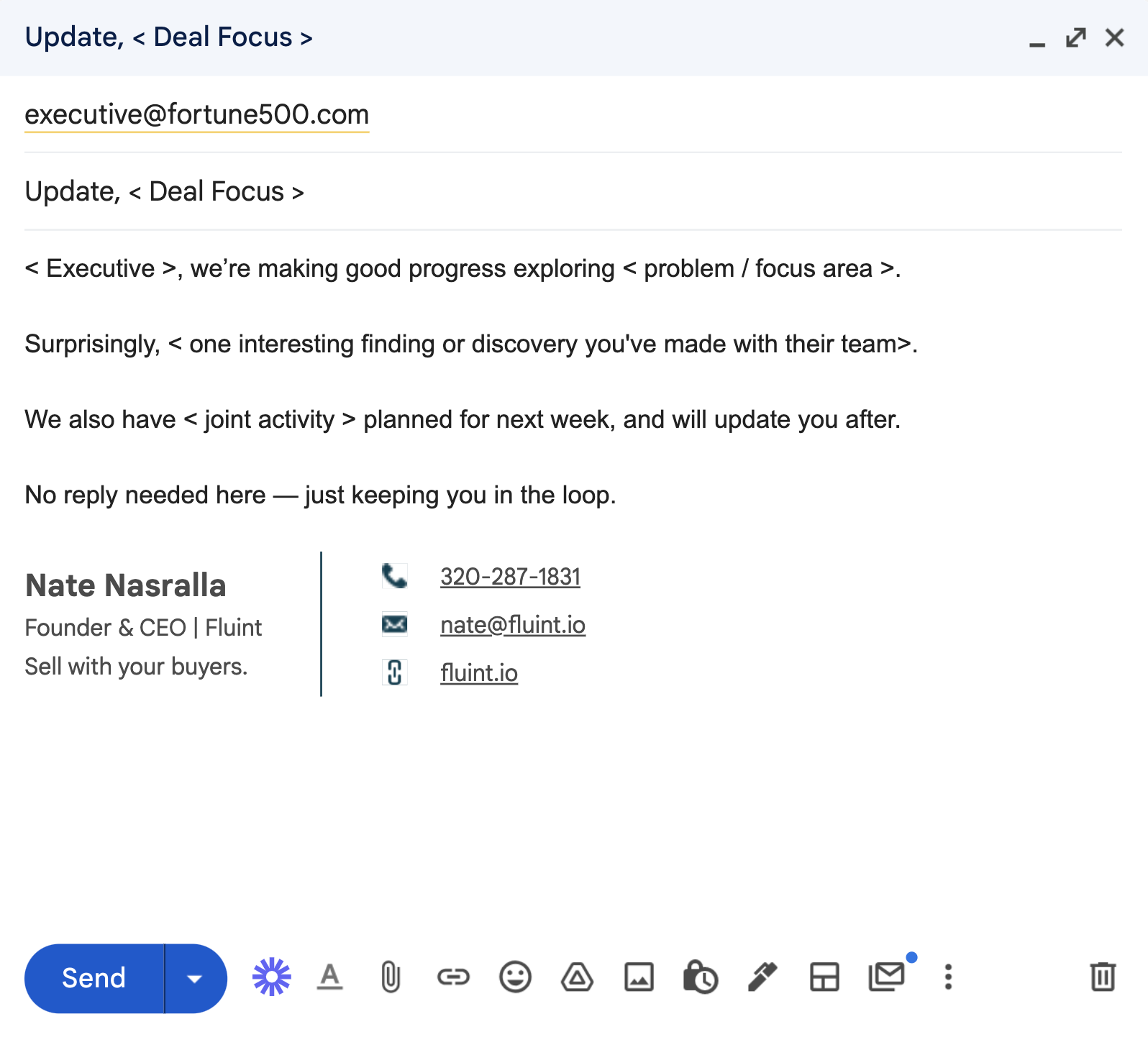
8/ The Creating-Action-from-Consensus Email
Complex deals aren’t complex because of the contract size. It’s the number of contacts involved, plus the need to create consensus from multiple sets of priorities and incentives.
When you see a way to tie together multiple goals in the buying committee, use this framework:
- Develop urgency by referencing a shared date or deadline.
- Connect that date back to each buyer’s personal goals.
- Link both of their goals together, using your product.
Here’s an example, where James is the Head of Sales, and Daniel is the Head of Marketing.

9/ The Account Team -> Rep -> Buyer Email
This one is crazy effective when executed well, and to genuinely help.
Here's how to use it for high-value, late-stage deals:
- Partner with your account team (could be a CSM, AM, or solutions engineer).
- Pick a few late-stage deals and detail the customer's current state.
- Find one way you both can help the buyer today.
- Give your team this email to send to you (the rep).
- Forward that email on to your buyer.
It's effective because:
- I can almost guarantee no competitor is doing this.
- It shows your buyers there's a whole team thinking about them.
- It actually "adds value" by helping buyers get a job done.
- It sets up a smooth handoff and implementation.
Here’s an example. Let's say you work with an operations team who doesn't have a master data hierarchy. Which throws off their segmentation and causes all kinds of issues. So you and your team modify a sample from another account and schedule a working session to refine it.

By the way, if you want to use this for multiple deals, use some of your commission check to send your colleague dinner. Or something to say you appreciate them, and their teamwork.
10/ The “Don’t Handle Objections Over Email,” Email
If you’re hit with an objection over email, it’s never ideal to “handle” it before understanding the true issue more deeply.
So the goal of this framework is to setup a call, while signaling you’re there to listen from a collaborative, curious posture. It works by:
- Showing you’re grateful they’ve raised an issue (instead of ghosting).
- “Actively reading” to isolate the objection into one core concern.
- Seeking to understand, before jumping right into a solution.
Here's an example of how this reads:
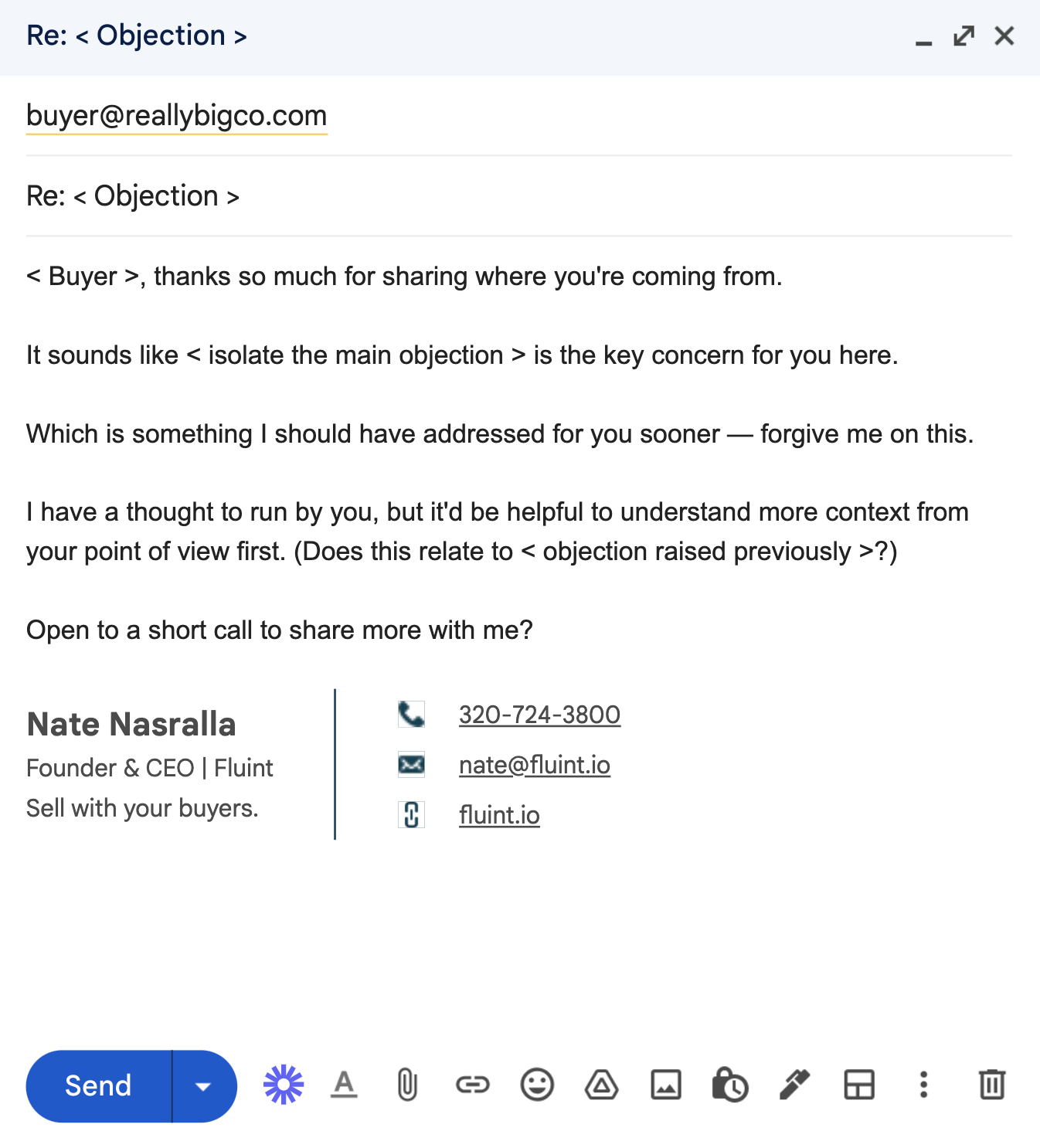
11/ The “I’m Behind on My Email,” Email
Here's one of the more underrated follow-up emails.
Sometimes, you need a little extra time to be thoughtful, so use this email as an alternative to:
- Sending an uninspiring, default template on-time.
- Sending a killer follow-up that's way late.
Really, this framework is just about communicating consistently. When you do, your message always lands. (As long as you don't use this one multiple times on the same account...)

12/ The Contract & Pricing Review Email
Should you send out your pricing over an email? The classic answer is, “it depends.”
- If you have a simple pricing model spelled out on your website, then yes.
- If it’s a complex model with multiple drivers and options, then no.
I’m guessing many of you reading this fall into the second case, so here’s your framework.
It's called the "4A's."
- Acknowledge the group’s needs.
- Affirm the goals of your pricing structure.
- Ask for feedback on the options created.
- Align with the right contacts in a conversation.
Here's how it reads:

By the way, when procurement hasn’t been involved yet, add a spin on this email by saying:
We’re both looking to setup a long-term relationship, and I’m sure your procurement team can help align our contract details with their vendor strategy.
Could we invite them, too?
You’ll eventually need to meet with them. So why not invite the conversation up front?
13/ The New Customer Feedback Email
At the risk of overstating it, this email can change the way you sell.
It’s fairly common to ask buyers for their ‘decision process,' and what they let you see is helpful. But it’s what you don’t see about the way your buyers buy that’s most valuable.
Here’s how to learn how your buyer's “internal sale” really goes down:
- Pick a deal that closed recently. Make sure you had an open, transparent champion.
- Write up the decision process you know, from what you heard and helped with.
- Ask your champion to point out any gaps. What did they do, that you didn’t see?
What you find will be fascinating.
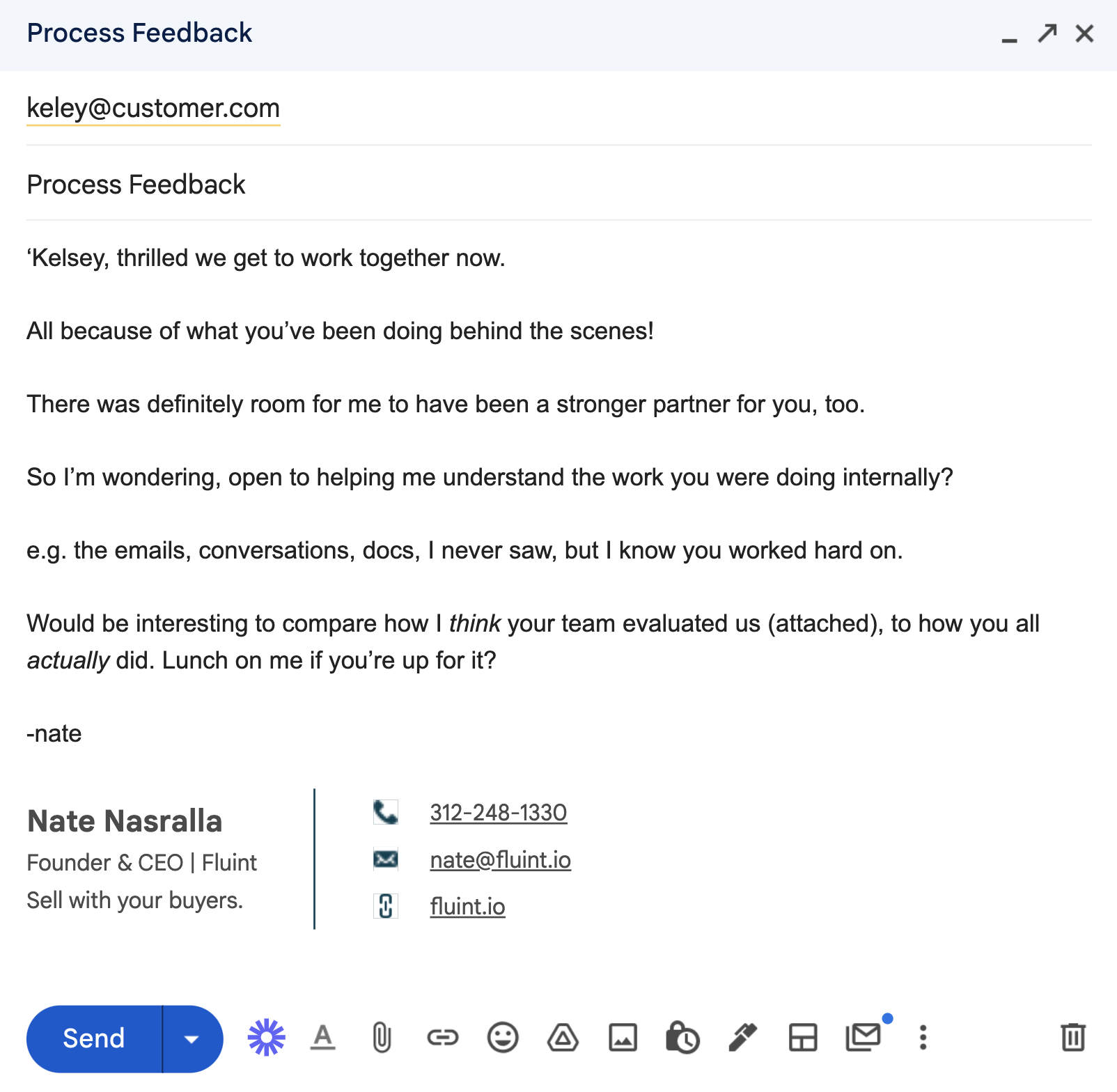
Final Thoughts on Writing Well
1/ Make sure your follow-up can pass this workflow.
If you want a detailed breakdown on each step, download the Forward-Worthy Follow-Up Guide.

2/ Ask your internal team to critique your emails.
Your own team is filled with people who think like and do the same job as your prospects. Plus, they have a natural incentive to help you improve your messaging.
So the idea here is:
- Selling to developers? Show your developers.
- Selling to marketing? Show your marketers.
- Selling to finance? Show your finance team.
- Selling to HR? Show your HR team.
- Selling to CS? Show your CS team.
- And so on.
3/ The top thing to remember when emailing execs.
They're reading your email during another conversation.
Which means you’ll only get a fraction of their full attention. They fit in a few emails here and there, while on a call that's running long, or in a meeting that doesn't need 100% focus.
This means it’s critical to:
- Put the bottom line up front (BLUF).
- Make it easy to forward to someone else.
- Write like a 5th-grader talks. Simple and easy.
4/ Check out more resources on writing in sales.
Why stop now?
You’re on a roll. Keep reading related write-up’s:
Draft with one click, go from DIY, to done-with-you AI
Get an executive-ready business case in seconds, built with your buyer's words and our AI.
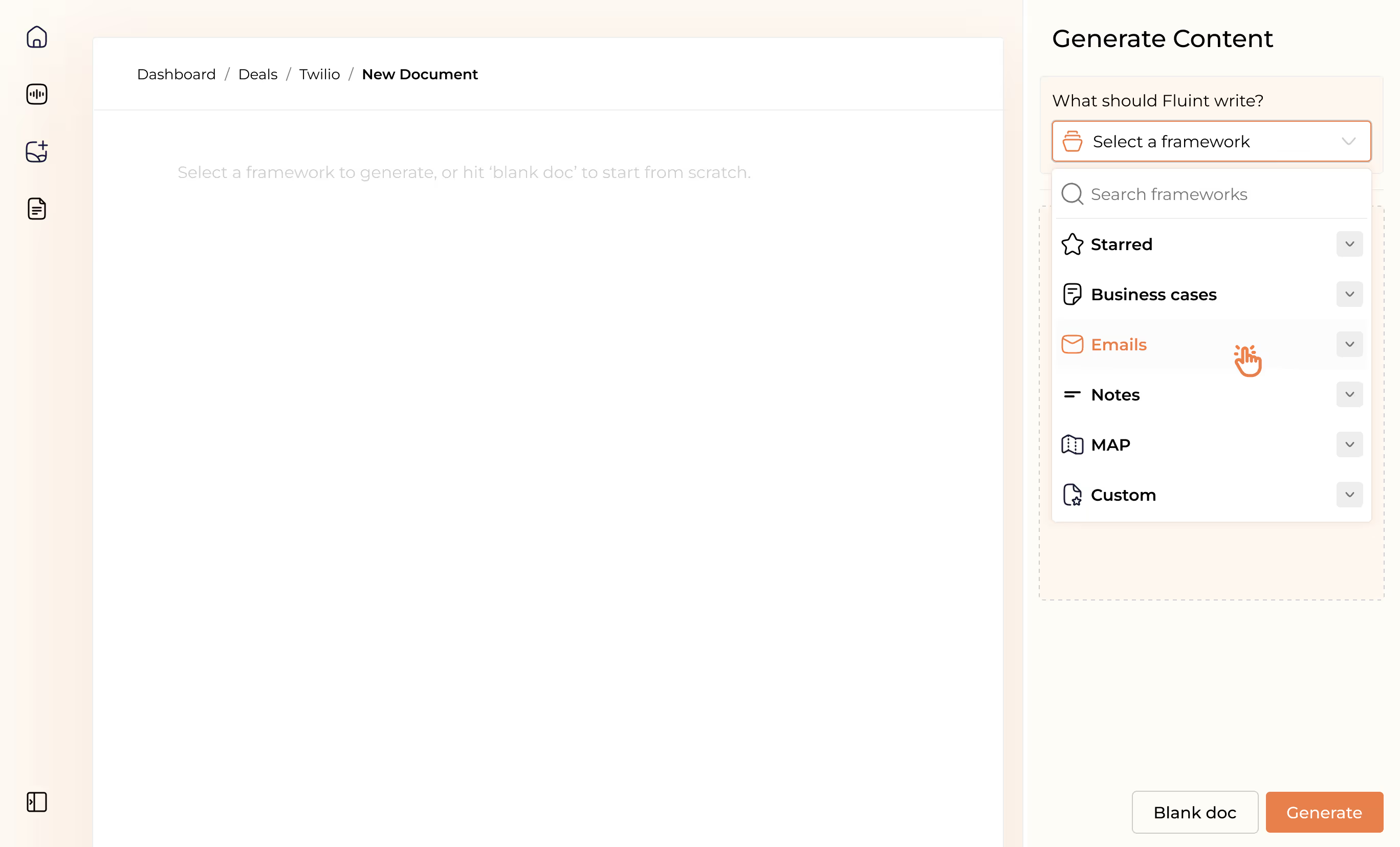
Meet the sellers simplifying complex deals
Loved by top performers from 500+ companies with over $250M in closed-won revenue, across 19,900 deals managed with Fluint

Now getting more call transcripts into the tool so I can do more of that 1-click goodness.



The buying team literally skipped entire steps in the decision process after seeing our champion lay out the value for them.


Which is what Fluint lets me do: enable my champions, by making it easy for them to sell what matters to them and impacts their role.




.png)
